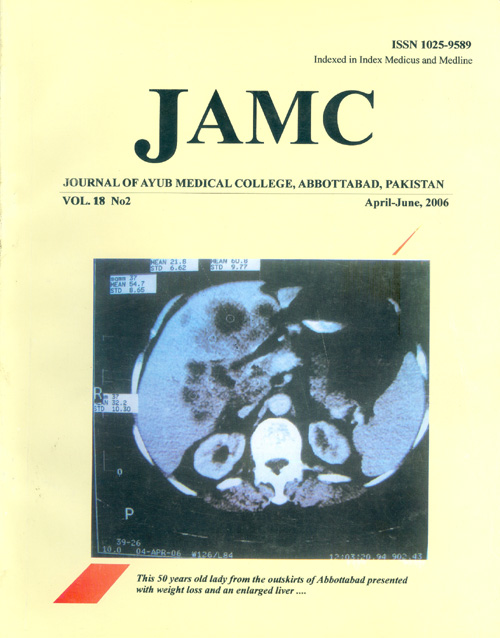AN ANALYSIS OF SURGICALLY MANAGED CASES OF PELVIC ABSCESS COMPLICATING UNSAFE ABORTION
Abstract
Background: This study was carried out to study the demographic variables, treatment optionsand mortality in cases of abortion related pelvic abscess. Methods: A retrospective study ofpatients that had pelvic abscess as a complication of unsafe abortion. The retrieved case files werescrutinized for the necessary information. Result: The age ranged from thirteen years to forty sixyears, and teenagers accounted for 24.3% of the patients. About half of the patients, 51.4% werechildless and parity ranged from zero to eight. The abortionists were mainly untrained personneland the contraceptive prevalence rate was low, 5.4%. Most of the patient had conservative surgeryand a significant number 94.6%, had blood transfusion. Maternal death of 18.9% was recordedwith infection being the major cause. Conclusion: Unsafe abortion and its attendant complicationis still a problem in Nigeria. High quality post abortion care will help a long way in saving manylives.Key words: Unsafe abortion, Induced abortion, Pelvic abscess, Conservative surgery.References
World Health Organization. Complications of abortion
technical and managerial guidelines for prevention and
treatment. Geneva: WHO. 1995.World Health Organization. The prevention and management
of unsafe abortion. Report of a technical working group.
WHOMSM92.5. Geneva: WHO, 2003.
Henshaw SK, Singh S, Oye-Adeniran BA, Adewole IF,
Iwere N, Cuca YP. The incidence of induced abortion in
Nigeria. Inter Fam Plann Persp 1998; 24(4):
Starrs A. The safe motherhood action agenda: Priorities for
the next decade. Washington DC. Family Care International
; 56.
Ransom EI, Yinger NV. Making motherhood safe:
Overcoming obstacles on the pathway to care. Population
reference Bureau. 2002; 8.
Unsafe Abortion: A major public health problem. Safe
motherhood. 2000; 28(1): 4.
World Health Organization. Unsafe abortion. Reproductive
health strategy: To accelerate progress towards the attainment
of international development goals and targets.
WHO/RHR/04.8:14.
Agadjanian V. “Quasi – Legal” abortion services in a SubSaharan setting: Users profile and motivations. InternationalFamily Planning Perspective 1998; 24(3):111-6.10. Ahmed mk, Rahman m, Ginneken JV. Induced abortion in
Matlab, Bangladesh: Trends and determinants. International
Family Planning Perspective. 1998: 24(3): 128 – 132.
Caldwell J, Cladwell P. Marital status and abortion in SubSaharan Africa. In: Nuptiality in Sub-Saharan Africa. Eds
Bledsoe C and Pison G. Oxford, UK. Clarendon Press. 1994:
– 25.12. Emuveyan EE, Agboghoroma OC. Trends in abortion related
maternal mortality in Lagos, Nigeria. Trop J Obstet Gynaecol
;14(1):39 – 41.
Protopapas AG, Diakomanolis, Milingos SD, Rodolakis AJ,
Markaki SN, Vlachos GD et al. Tubo-ovarian abscesses in
postmenopausal women: Gynecological malignancy until
proven otherwise? Europ J Obstet Gynaecol and Reprod Biol.
; 144: 203-9.
Slap GB, Forke CM, Cnaan A, Bellah RD, Kreider ME,
Hanissian JA et al. Recognition of tubo-ovarian abscess in
adolescent with pelvic inflammatory disease. J Adolescent
Health. 1996; 18: 397 – 403.15. Hassaan M, Tamara T, Habib S. Conservative vs radical
management in pelvic abscess. Int J of Gynaecol Obstet
; 70(2): B40.16. Mirhashemi R, Wolfgang M, Schoell J, Estape R, Angiolo R,
Averette HE. Trends in the management of pelvic abscess. J
Am Coll Surg. 1999; 188(5): 567-72.
Kaplan AL, Jacobs WM, Ehresman JB. Aggressive management of pelvic abscess. Am J Obstet Gynaecol 1967; 98: 482
-7.
Liljestrand J, Gryboski K. Maternal mortality as a human
right issue. In: Reproductive Health and Rights. PATH and
the Women Reproductive Health Initiative. Washington DC.
Issue
Section
License
Journal of Ayub Medical College, Abbottabad is an OPEN ACCESS JOURNAL which means that all content is FREELY available without charge to all users whether registered with the journal or not. The work published by J Ayub Med Coll Abbottabad is licensed and distributed under the creative commons License CC BY ND Attribution-NoDerivs. Material printed in this journal is OPEN to access, and are FREE for use in academic and research work with proper citation. J Ayub Med Coll Abbottabad accepts only original material for publication with the understanding that except for abstracts, no part of the data has been published or will be submitted for publication elsewhere before appearing in J Ayub Med Coll Abbottabad. The Editorial Board of J Ayub Med Coll Abbottabad makes every effort to ensure the accuracy and authenticity of material printed in J Ayub Med Coll Abbottabad. However, conclusions and statements expressed are views of the authors and do not reflect the opinion/policy of J Ayub Med Coll Abbottabad or the Editorial Board.
USERS are allowed to read, download, copy, distribute, print, search, or link to the full texts of the articles, or use them for any other lawful purpose, without asking prior permission from the publisher or the author. This is in accordance with the BOAI definition of open access.
AUTHORS retain the rights of free downloading/unlimited e-print of full text and sharing/disseminating the article without any restriction, by any means including twitter, scholarly collaboration networks such as ResearchGate, Academia.eu, and social media sites such as Twitter, LinkedIn, Google Scholar and any other professional or academic networking site.









